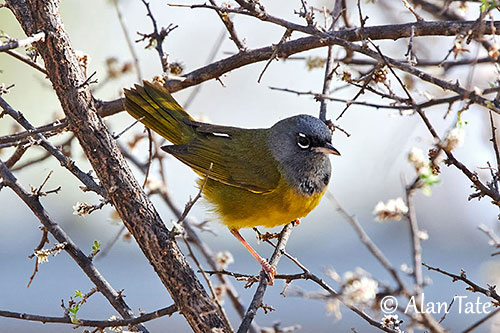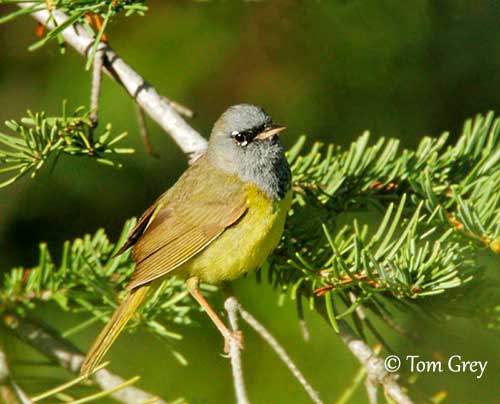
Fr: Paruline des buissons
Ang: MacGillivray's Warbler
All: Dickichtwaldsänger
Esp: Reinita de Tolmie
Ita: Parula di MacGillivray
Nd: Rouwkopzanger
Sd: gråhuvad skogssångare
Photographers:
Tom Grey
Tom Grey's Bird Pictures & Tom Grey's Bird Pictures 2
Patrick Ingremeau
TAMANDUA
Alan & Ann Tate
AA Bird Photography
Text by Nicole Bouglouan
Sources:
HANDBOOK OF THE BIRDS OF THE WORLD Vol 15 by Josep del Hoyo-Andrew Elliot-David Christie - Lynx Edicions – ISBN: 9788496553682
FIELD GUIDE TO THE BIRDS OF NORTH AMERICA - National Geographic Society - ISBN: 0792274512
Bird Web (Seattle Audubon Society)
Animal Diversity Web (University of Michigan Museum of Zoology)
What Bird-The ultimate Bird Guide (Mitchell Waite)
California Partners in Flight Coniferous Bird Conservation Plan for the MacGillivray’s Warbler
Wikipedia, the free encyclopaedia
MacGillivray's Warbler
Geothlypis tolmiei
Passeriformes Order – Parulidae Family
INTRODUCTION:
The MacGillivray's Warbler is a highly migratory species. It breeds in W North America and SE Alaska, and as far as S Arizona and S California. It migrates by night to spend the winter in Mexico and Central America. It spends most of its time in dense undergrowth and forages on the ground where it catches insects, or gleans food items from leaves and searches for prey in tree bark and shrubs.
During the breeding season, the male sings to defend the territory. They build a cup-shaped nest among the vegetation, but fairly close to the ground. Both parents feed the chicks.
This species was named by John James Audubon in honour of his friend the Scottish ornithologist William Mag Gillivray, whereas the specific name pays tribute to the doctor and explorer Dr. William Fraser Tolmie.
The MacGillivray's Warbler is threatened by habitat loss in some parts of the range and long-term consequences of deforestation providing unsuitable nesting habitats.
The species is slowly declining, but currently, it is not considered globally threatened.

The female resembles male but she has much paler grey hood with whitish to grey-buff chin and throat.
The juvenile has mostly brownish-olive plumage. On the upperwing, greater and median coverts show pale cinnamon wingbars. There is a pale yellow wash on the lower underparts.
The 1st year male resembles female with greyer throat and sometimes faint black mottling on breast sides. By spring, it is slightly duller than adult male.
The 1st year female is duller than adult, with brownish-olive hood and mostly buffy throat. By spring, it is very similar to adult female.
SUBSPECIES AND RANGE:
The MacGillivray's Warbler has two subspecies.
G.t. tolmiei (described above) breeds on Pacific coastal regions (W of the Cascades) from extreme SE Alaska and S Yukon, S in W USA to C California.
It winters from Mexico S to Guatemala, but they are less numerous in W Panama.
G.t. monticola breeds from SW Canada, S in Rocky Mountains and adjacent areas to Arizona and New Mexico.
It winters mainly in the highlands of C and S Mexico. It is vagrant to S California.
This race is slightly duller than nominate. It has a greyish tinge above and a greenish wash below. The tail is slightly longer.
HABITAT:
The MacGillivray's Warbler breeds in thickets (willow and alder) up to 3,000 metres of elevation, in secondary growth of conifers and adjacent corridors.
In the northern parts of the range, they are found in deciduous forests and even in chaparral.
During migration, they frequent dense shrubs in mountainous areas.
During winter, they are found in humid or semi-arid second growth forests and forest undergrowth in both foothills and mountains.
CALLS AND SONGS: SOUNDS BY XENO-CANTO
The MacGillivray's Warbler gives a sharp, harsh “tsik” as usual call, and the flight call is a penetrating “tseep” very similar to the flight call of the Mourning Warbler.
The song has two parts, with 3-4 buzzy “tchee” notes followed by 2-3 more warbled “teeoo” notes on lower pitch.
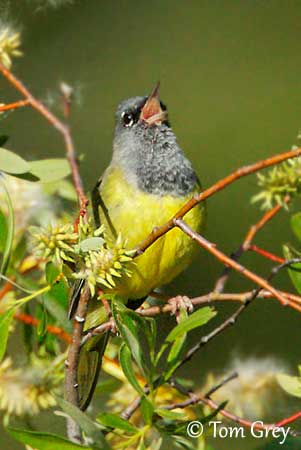
BEHAVIOUR IN THE WILD:
The MacGillivray's Warbler feeds mainly on insects including various species such as beetles, bees, wasps, ants, true bugs, caterpillars and weevils.
It gleans prey from bark and vegetation, often low in the forest. It usually forages in dense, wet thickets but mostly close to the ground. It hops while searching for prey on the ground. During winter, it defends the feeding territory and usually forages alone.
In Colorado, young birds are observed taking sap from holes in willows, drilled by sapsuckers.
During the breeding season, the male sings to defend the nesting territory. It sings mainly at dawn and dusk, perched 5-7 metres above the ground. Males sometimes chase each other, but they rarely fight. The pairs are seasonally monogamous.
This species nests in an open cup usually hidden low in bush or dense shrubs.
The MacGillivray's Warbler and the Mourning Warbler are known to hybridize when their ranges overlap, although recent authors have doubted these reports.
Both species have extensive range contact in the southern Peace Region of British Columbia, E of Rocky Mountains. In the contact zone, many birds show a combination of features typical of both species.
The MacGillivray's Warbler is migratory. It leaves the breeding grounds from early August, following a route southwards along the W coast and mountains ranges. They arrive on the wintering grounds from late August/early September.
The spring migration starts in March along the same route. They arrive on their breeding areas from early April in S, and early May in N.
This species has fairly swift, direct flight over short distances. It performs short bursts from one perch in vegetation to another.
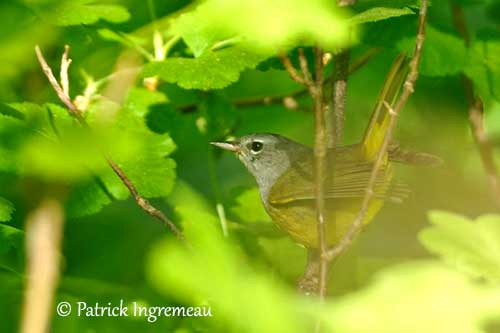
REPRODUCTION OF THIS SPECIES:
The breeding season occurs between May and August, with the egg-laying in May-July.
The nest-site of the MacGillivray's Warbler is often hidden in dense shrubs, in upright fork of tree, usually 30-150 centimetres above the ground. It is placed in shady damp area or among tall weeds and ferns.
The loose structure is an open cup made of weed stems, dry grass and bark shreds. The cup is lined with softer grasses, rootlets and hair. It is probably built by both adults.
The female lays 3-6, usually 4 creamy-white eggs with brown markings. At hatching, the chicks are naked. They constantly beg for food and both parents feed them. The young fledge 8-9 days after hatching, and they remain in family group for some time after.
This species produces a single brood per season.
PROTECTION / THREATS / STATUS:
The MacGillivray's Warbler is described as “fairly common” throughout the range. Some local decreases are the result of human disturbances of forest habitats that destroy potential suitable habitat. However, other disturbances create dense shrubby tangles favoured by this species.
The population size is extremely large, and despite some local declines, the species is not globally threatened.
The MacGillivray's Warbler is currently evaluated as Least Concern.
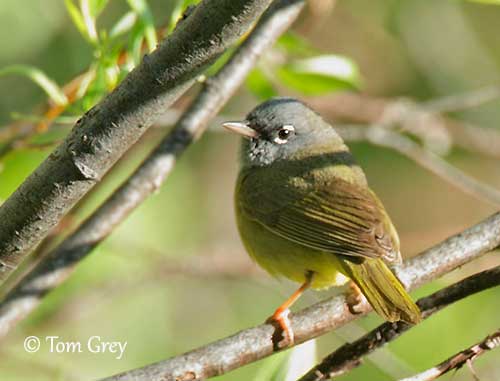
DESCRIPTION OF THE BIRD:
Biometrics:
Length: 13 cm
Weight: 8,5-12,5 g
The MacGillivray's Warbler is very similar to the Mourning Warbler, a closely related eastern species. They have similar plumage, except for the white crescents above and below the eye (in MacGillivray's Warbler). Both species hybridize where their ranges overlap. But following recent analysis, differences occur in morphology, song and breeding range. They were once considered the same species, but today, they are two distinct species.
The MacGillivray's Warbler male of nominate race has olive-green upperparts and yellow underparts.
It has grey hood with black lores. We can see two conspicuous white crescents, above and below each eye. The breast is finely mottled with black.
The two-tone bill has flesh-coloured lower mandible, whereas the upper mandible is darker with blackish culmen. The eyes are dark brown. Legs and feet are pale pinkish.
